Last Updated: Apr 14, 2022
Quick Links: Table of Contents
- How Smart is the Great Pyrenees?
- Great Pyrenees Intelligence. A Second Opinion
- The Intelligence of Great Pyrenees Compared to Other Dog Breeds
- Is the Great Pyrenees Smarter than a Cat?
- What is the IQ of the Great Pyrenees?
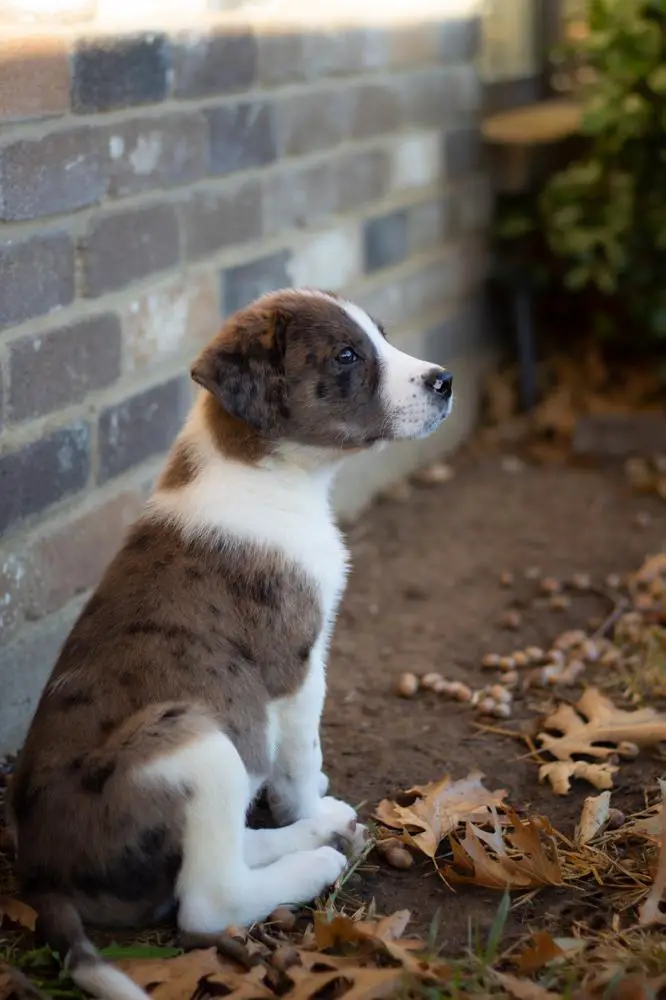
How Smart is the Great Pyrenees?
The Great Pyrenees is a dog breed that is known to be:
- Affectionate
- Confident
- Fearless
- Gentle
- Patient
- Strong-willed
But, how smart is the Great Pyrenees really?
The Great Pyrenees is the 64th smartest dog when it comes to obedience and working intelligence.
Accordingly, compared to other dogs, the Great Pyrenees belongs to the `Fair Working/Obedience Intelligence Dogs` category.
Great Pyreneess tend to learn new commands after 40 to 80 repetitions!.
These facts on Great Pyrenees intelligence are from the published work on dog intelligence and behavior by the renowned Prof. Stanley Coren. Coren is a Canadian Psychology Professor and Dog Researcher.
In the 1990s, Prof. Coren did extensive scientific research where he `measured` what is called the Working or Obedience Intelligence of more than 130 different dog breeds.
Note that the working/obedience intelligence of a dog is one of the three intelligence components that constitute a dog`s total intelligence. But it is the only intelligence component that can be measured and compared among dog breeds.
Later on, we will further explain what the working/obedience intelligence means, and what the other two parts of a dog`s intelligence are.
For his research on measuring and ranking the intelligence of dog breeds, Prof. Coren consulted with:
- Over two hundred dog obedience judges
- Over sixty veterinarians, and
- Fourteen guard dog experts
From his research data, Prof. Coren ranked dog breeds according to their obedience intelligence from the smartest to the least smart.
According to the study, the smartest dog breed is the Border Collie. Border Collies are so smart that they can understand any new command that you are trying to teach them after repeating the command to them five times or fewer.
The least smart dog breed is the Afghan Hound. The Afghan Hound is one of the dog breeds with the lowest degree of Working/Obedience intelligence. It will take 80 to 100 repetitions or more for an Afghan Hound to learn a new command.
As mentioned earlier, the Great Pyrenees is the 64th smartest dog breed.
Furthermore, Coren placed dog breeds into one of six intelligence categories:
- Brightest Dogs: Tend To Learn New Commands After Fewer Than 5 Repetitions
- Excellent Working Dogs: Tend To Learn New Commands After 5 To 15 Repetitions
- Above Average Working Dogs: Tend To Learn New Commands After 15 To 25 Repetitions
- Average Working/Obedience Intelligence Dogs: Tend To Learn New Commands After 25 To 40 Repetitions
- Fair Working/Obedience Intelligence Dogs: Tend To Learn New Commands After 40 To 80 Repetitions!
- Lowest Degree of Working/Obedience Intelligence Dogs: Tend To Learn New Commands After 80 To 100 Repetitions Or More!
The Great Pyrenees belongs to the `Fair Working/Obedience Intelligence Dogs` category.
However, note that obedience intelligence is one of the many things that make a good dog. The fact that a dog breed has a low obedience intelligence DOES NOT MEAN the dog breed with not excel at other things.
Intelligence is just one of the many things that make dogs the excellent human companions that they are.
See the intelligence ranking of a few selected dog breeds in the table below: (note, although 133 dog breeds were studied, there are 79 positions because some breeds tied for the same position)
Click here to see the intelligence rank of all 133 dog breeds.
| Breed | Intelligence Rank |
|---|---|
| How Smart is the Doberman Pinscher? | Ranked 5th out of 79 |
| How Smart is the Australian Cattle Dog? | Ranked 10th out of 79 |
| How Smart is the Miniature Schnauzer? | Ranked 12th out of 79 |
| How Smart is the English Cocker Spaniel? | Ranked 18th out of 79 |
| How Smart is the Newfoundland? | Ranked 34th out of 79 |
| How Smart is the Saluki? | Ranked 43rd out of 79 |
| How Smart is the Siberian Husky? | Ranked 45th out of 79 |
| How Smart is the West Highland White Terrier? | Ranked 47th out of 79 |
| How Smart is the Pug? | Ranked 57th out of 79 |
| How Smart is the French Bulldog? | Ranked 58th out of 79 |
| How Smart is the Maltese? | Ranked 59th out of 79 |
| How Smart is the Chinese Crested? | Ranked 61st out of 79 |
| How Smart is the Great Pyrenees? | Ranked 64th out of 79 |
| How Smart is the Basset Hound? | Ranked 71st out of 79 |
| How Smart is the Bulldog? | Ranked 77th out of 79 |
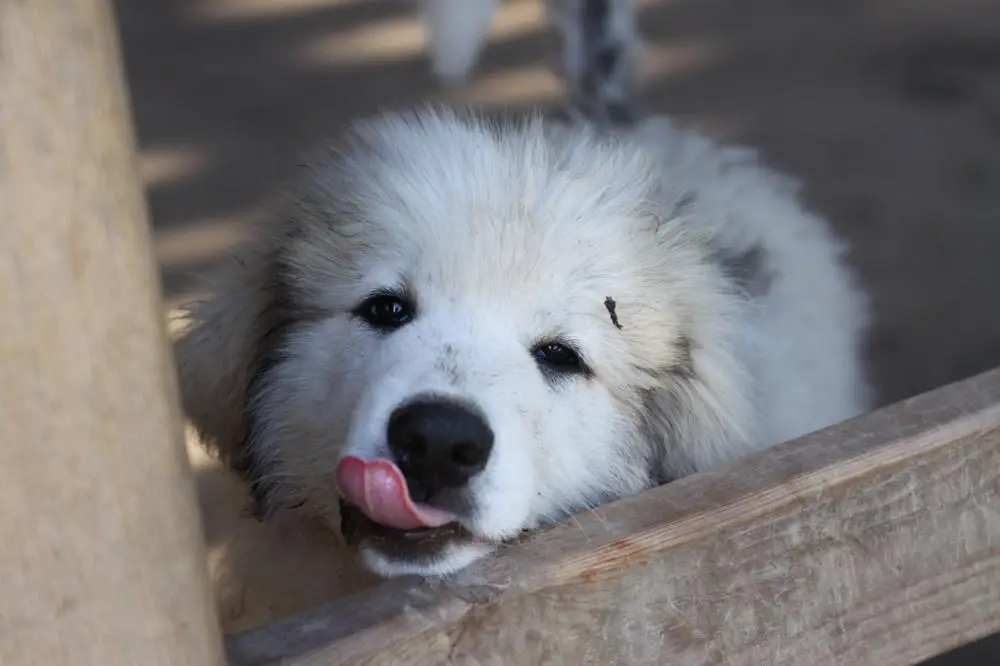
Great Pyrenees Intelligence. A Second Opinion
We reviewed another research study to find out more about the intelligence of the Great Pyrenees. This other study is The Canine Behavioral Assessment & Research Questionnaire (C-BARQ) study.
This study was done by research veterinarians from the University of Pennsylvania.
In the study, the researchers asked owners of different dog breeds, including owners of the Great Pyrenees to describe how trainable their dogs are.
32 Great Pyrenees owners were asked to describe
how easy it was to train their Great Pyrenees in the CBARQ research survey.We analyzed what these Great Pyrenees owners said about the trainability of their Great Pyreneess and compared that to what other owners said about other dog breeds (125 other breeds).
Dogs that are easy to train are always very eager to listen to their owner. These dogs are not stubborn. These dogs obey simple commands, and they learn very quickly.
Also, dogs that are easy to train tend to do well at fetching objects when asked to. Furthermore, this category of dogs also responds positively to correction and ignores distraction.
According to the results from the CBARQ research, Great Pyreneess are not easy to train.
In fact, the Great Pyrenees ranks 100th out of 124 dog breeds for easiness to train.
Based on our further analysis of the CBARQ research data, we found that the Great Pyrenees has a trainability score of 50.2 %.
Other dog breeds that are not easy to train just like the Great Pyrenees are listed in the table below:
| Trainability Rank | Breed | Trainability Score |
|---|---|---|
| 97 | Old English Sheepdog | 52.5 % |
| 98 | American Eskimo Dog | 52.3 % |
| 99 | Shiba Inu | 52.1 % |
| 100 | Great Pyrenees | 50.2 % |
| 101 | Fox Terrier (Smooth) | 50.0 % |
| 102 | Black and Tan Coonhound | 48.6 % |
| 103 | Lhasa Apso | 47.8 % |
According to the CBARQ research data, the dog breeds that are most easy to train are the:
According to the CBARQ research data, the dog breeds that are most difficult to train are the:
However, it is important to note that trainability does not always equal intelligence.
This is because a dog can be smart and stubborn at the same time. A smart but stubborn dog will be hard to train.
Visit this page to see the complete temperament profile (trainability, aggression, shyness, prey drive, etc) of the Great Pyrenees according to the result of the CBARQ research study.
The Three Parts of the Intelligence of the Great Pyrenees
As mentioned earlier, Prof. Coren ranked dogs based on what is called the `Working/Obedience` Intelligence.
The `Working/Obedience` Intelligence is one of the three parts of a dog`s overall intelligence.
All the three parts that make up a dog`s overall intelligence are:
- Instinctive Intelligence: This is the natural intelligence that comes from instinct. For example, dog breeds that have been historically bred to be guard or hunt dogs will have a high `guarding` or `hunting` intelligence compared to dogs that were not bred for guarding or hunting.
- Adaptive Intelligence: This indicates what a dog can learn to do for himself or herself. Adaptive intelligence is specific to each dog, and not specific to a dog breed. You can improve your dog`s adaptive intelligence (and therefore its overall intelligence) by investing time to train your dog.
- Working/Obedience Intelligence: This intelligence type is the subject of this article. This type of intelligence is breed-specific. Certain dog breeds tend to have higher working/obedience intelligence than other breeds. This intelligence is the closest to what we might call school-learning ability and it is based upon what the dog can learn to do when instructed by humans. This type of intelligence can be measured for each dog breed. Furthermore, the working/obedience intelligence of one dog breed can be compared to that of another dog breed to see which dog is smarter
You can tell what type of instinctive intelligence a dog breed will have based on the dog group the dog belongs.
The Great Pyrenees belongs to the Working Dogs group.
Dogs in the Working Dogs group, like the Great Pyrenees, were developed to assist humans in some capacity – including pulling sleds and carts, guarding flocks, guarding homes, and protecting their families.
Breeds in the Working Group are known for their imposing stature, strength, intelligence, and fearless..
The natural breed-specific working/obedience intelligence is a heavy chunk of a dog`s overall intelligence.
According to Prof. Coren, 51 percent of a dog`s intelligence comes from its genes while 49 percent of a dog`s intelligence comes from the dog`s environmental circumstances. Environmental circumstances include how much training you give to a dog.
In short, it will be much easier to train a naturally smart dog.
However, we should mention that a dog breed should not be judged based on its intelligence alone.
There are other important factors you need to consider when deciding on which dog breed to get.
The most important factor to consider is how compatible a dog breed`s overall temperament is with your lifestyle.
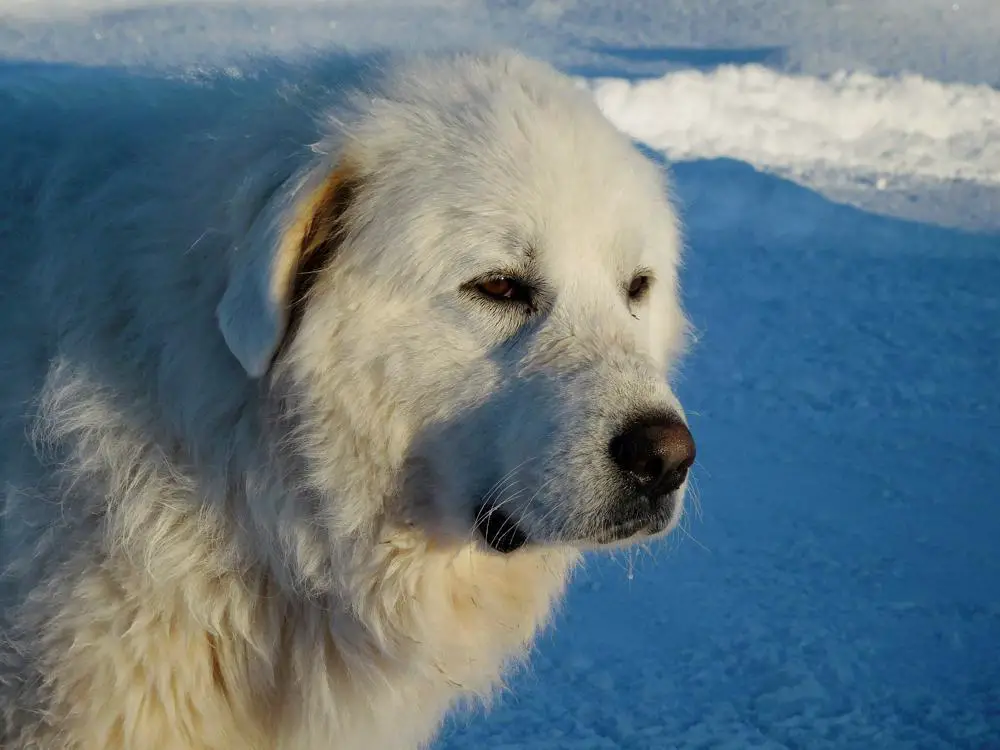
The Intelligence of Great Pyrenees Compared to Other Dog Breeds
See how smart the Great Pyrenees is compared to some other dog breeds.
To see how smart the Great Pyrenees is compared to all other dog breeds, see this ranking of dog breeds based on intelligence.
Is the Great Pyrenees Smarter Than the Saluki?
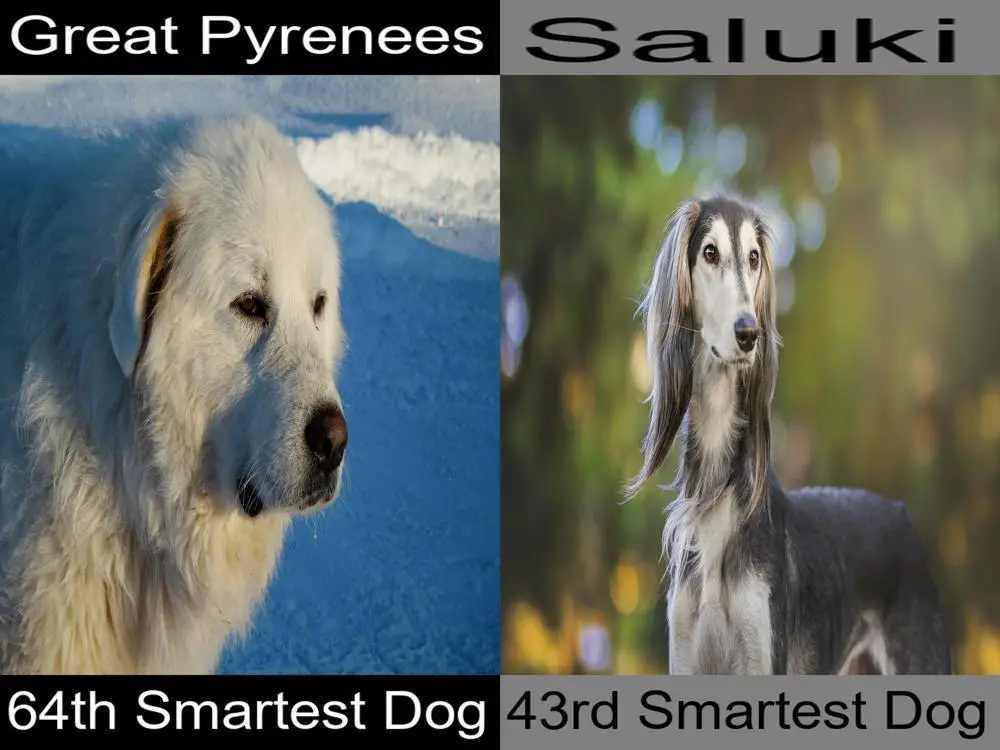
The Saluki is smarter than the Great Pyrenees.
This is because the Saluki ranks 43rd out of 79 in the intelligence ranking of 133 dog breeds, while the intelligence rank of the Great Pyrenees is 64th out of 79 in the ranking of the intelligence of 133 dog breeds (133 and not 79 because some breeds tied for intelligence in the same spot).
Because of its intelligence rank of 64th, the Great Pyrenees belongs to the `Fair Working/Obedience Intelligence Dogs` category.
This means that Great Pyreneess tend to learn new commands after 40 to 80 repetitions!.
On the other hand, because of its intelligence rank of 43rd, the Saluki belongs to the `Average Working/Obedience Intelligence Dogs` category.
This means that Salukis tend to learn new commands after 25 to 40 repetitions.
| Great Pyrenees | Saluki | |
|---|---|---|
| Intelligence Rank | 64th out of 133 dog breeds | 43rd out of 133 dog breeds |
| Learning Ability | Tend To Learn New Commands After 40 To 80 Repetitions! | Tend To Learn New Commands After 25 To 40 Repetitions |
Learn more about how smart Salukis are here.
Is the Great Pyrenees Smarter Than the Field Spaniel?
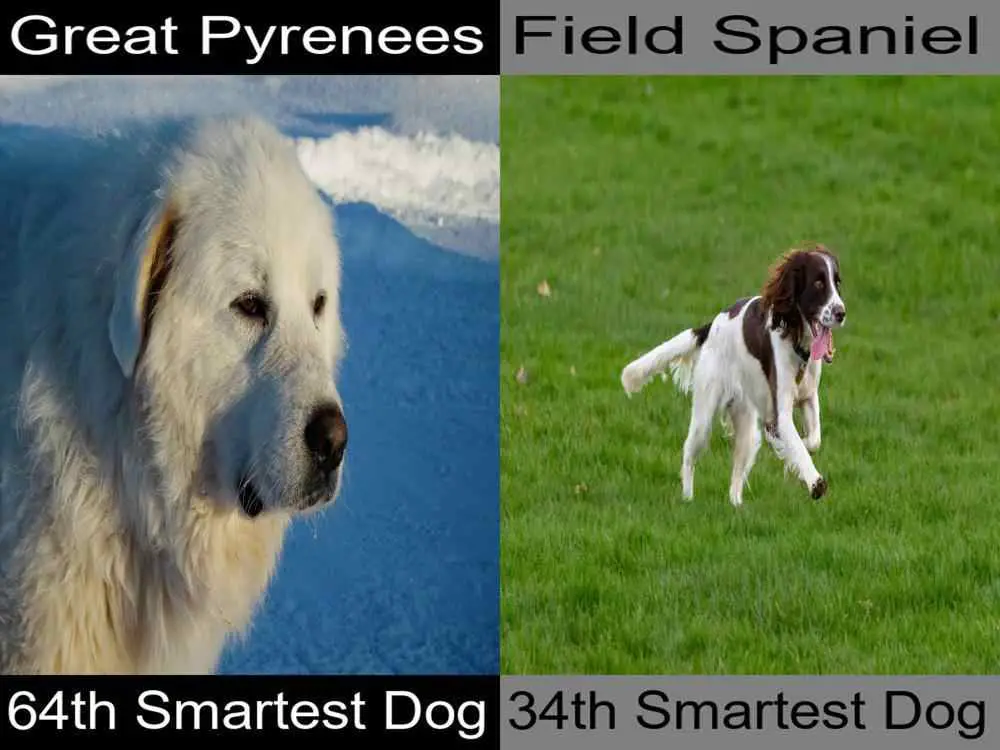
The Field Spaniel is smarter than the Great Pyrenees.
This is because the Field Spaniel ranks 34th out of 79 in the intelligence ranking of 133 dog breeds, while the intelligence rank of the Great Pyrenees is 64th out of 79 in the ranking of the intelligence of 133 dog breeds (133 and not 79 because some breeds tied for intelligence in the same spot).
Because of its intelligence rank of 64th, the Great Pyrenees belongs to the `Fair Working/Obedience Intelligence Dogs` category.
This means that Great Pyreneess tend to learn new commands after 40 to 80 repetitions!.
On the other hand, because of its intelligence rank of 34th, the Field Spaniel belongs to the `Above Average Working Dogs` category.
This means that Field Spaniels tend to learn new commands after 15 to 25 repetitions.
| Great Pyrenees | Field Spaniel | |
|---|---|---|
| Intelligence Rank | 64th out of 133 dog breeds | 34th out of 133 dog breeds |
| Learning Ability | Tend To Learn New Commands After 40 To 80 Repetitions! | Tend To Learn New Commands After 15 To 25 Repetitions |
Learn more about how smart Field Spaniels are here.
Is the Great Pyrenees Smarter Than the Collie?

The Collie is smarter than the Great Pyrenees.
This is because the Collie ranks 16th out of 79 in the intelligence ranking of 133 dog breeds, while the intelligence rank of the Great Pyrenees is 64th out of 79 in the ranking of the intelligence of 133 dog breeds (133 and not 79 because some breeds tied for intelligence in the same spot).
Because of its intelligence rank of 64th, the Great Pyrenees belongs to the `Fair Working/Obedience Intelligence Dogs` category.
This means that Great Pyreneess tend to learn new commands after 40 to 80 repetitions!.
On the other hand, because of its intelligence rank of 16th, the Collie belongs to the `Excellent Working Dogs` category.
This means that Collies tend to learn new commands after 5 to 15 repetitions.
| Great Pyrenees | Collie | |
|---|---|---|
| Intelligence Rank | 64th out of 133 dog breeds | 16th out of 133 dog breeds |
| Learning Ability | Tend To Learn New Commands After 40 To 80 Repetitions! | Tend To Learn New Commands After 5 To 15 Repetitions |
Learn more about how smart Collies are here.
Is the Great Pyrenees Smarter Than the Weimaraner?
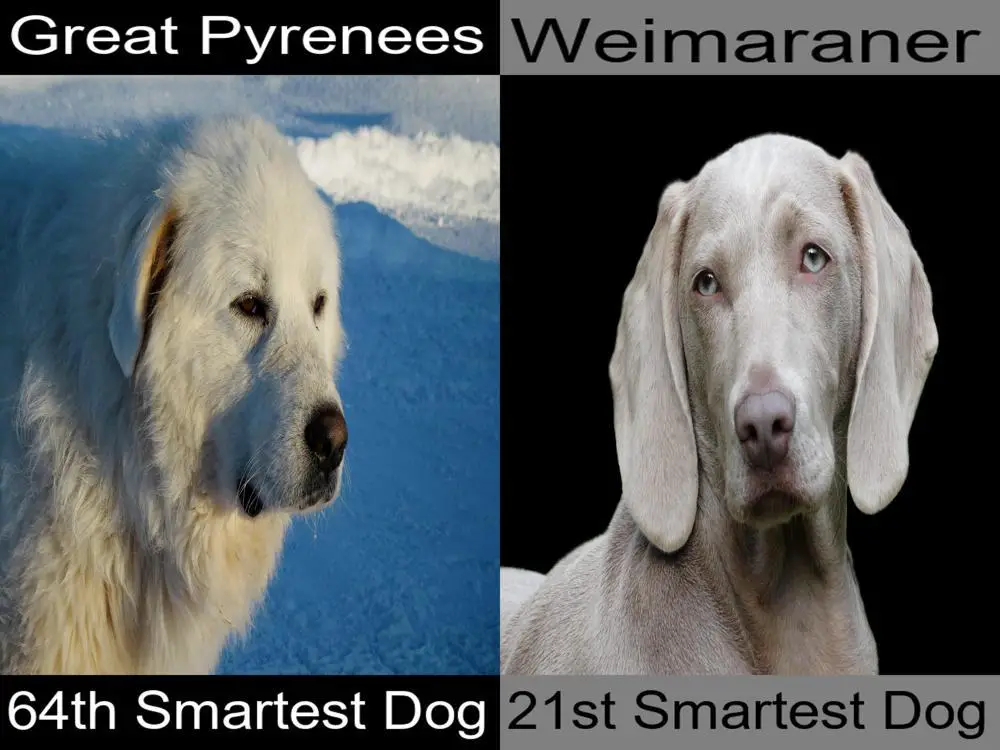
The Weimaraner is smarter than the Great Pyrenees.
This is because the Weimaraner ranks 21st out of 79 in the intelligence ranking of 133 dog breeds, while the intelligence rank of the Great Pyrenees is 64th out of 79 in the ranking of the intelligence of 133 dog breeds (133 and not 79 because some breeds tied for intelligence in the same spot).
Because of its intelligence rank of 64th, the Great Pyrenees belongs to the `Fair Working/Obedience Intelligence Dogs` category.
This means that Great Pyreneess tend to learn new commands after 40 to 80 repetitions!.
On the other hand, because of its intelligence rank of 21st, the Weimaraner belongs to the `Excellent Working Dogs` category.
This means that Weimaraners tend to learn new commands after 5 to 15 repetitions.
| Great Pyrenees | Weimaraner | |
|---|---|---|
| Intelligence Rank | 64th out of 133 dog breeds | 21st out of 133 dog breeds |
| Learning Ability | Tend To Learn New Commands After 40 To 80 Repetitions! | Tend To Learn New Commands After 5 To 15 Repetitions |
Learn more about how smart Weimaraners are here.
Is the Great Pyrenees Smarter Than the Welsh Springer Spaniel?
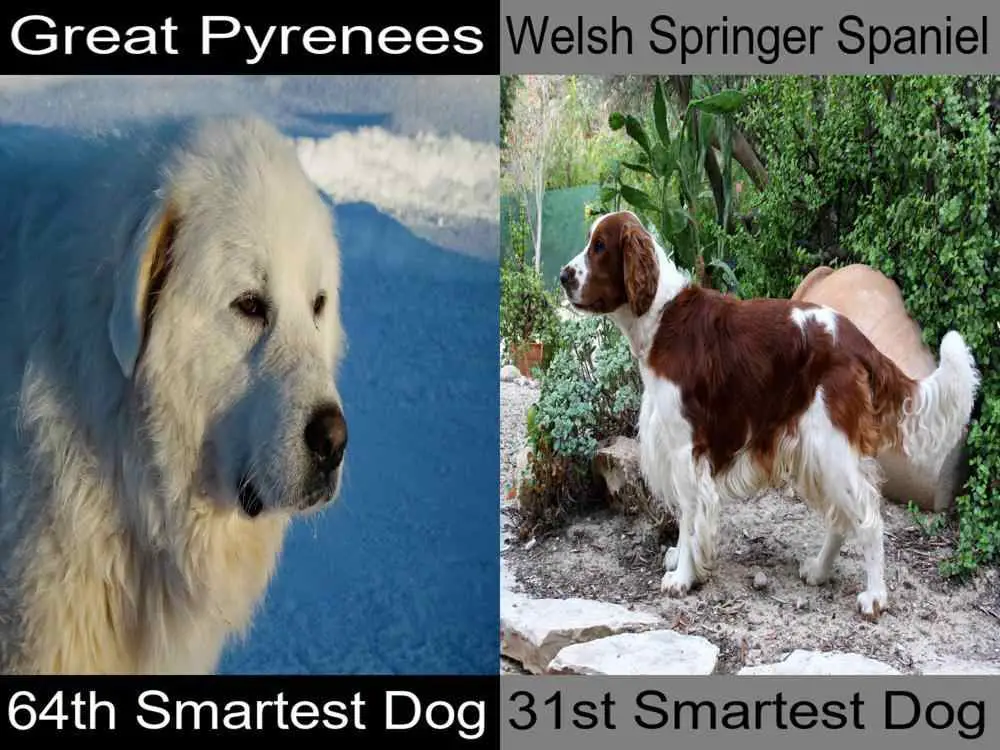
The Welsh Springer Spaniel is smarter than the Great Pyrenees.
This is because the Welsh Springer Spaniel ranks 31st out of 79 in the intelligence ranking of 133 dog breeds, while the intelligence rank of the Great Pyrenees is 64th out of 79 in the ranking of the intelligence of 133 dog breeds (133 and not 79 because some breeds tied for intelligence in the same spot).
Because of its intelligence rank of 64th, the Great Pyrenees belongs to the `Fair Working/Obedience Intelligence Dogs` category.
This means that Great Pyreneess tend to learn new commands after 40 to 80 repetitions!.
On the other hand, because of its intelligence rank of 31st, the Welsh Springer Spaniel belongs to the `Above Average Working Dogs` category.
This means that Welsh Springer Spaniels tend to learn new commands after 15 to 25 repetitions.
| Great Pyrenees | Welsh Springer Spaniel | |
|---|---|---|
| Intelligence Rank | 64th out of 133 dog breeds | 31st out of 133 dog breeds |
| Learning Ability | Tend To Learn New Commands After 40 To 80 Repetitions! | Tend To Learn New Commands After 15 To 25 Repetitions |
Learn more about how smart Welsh Springer Spaniels are here.
Is the Great Pyrenees Smarter than a Cat?
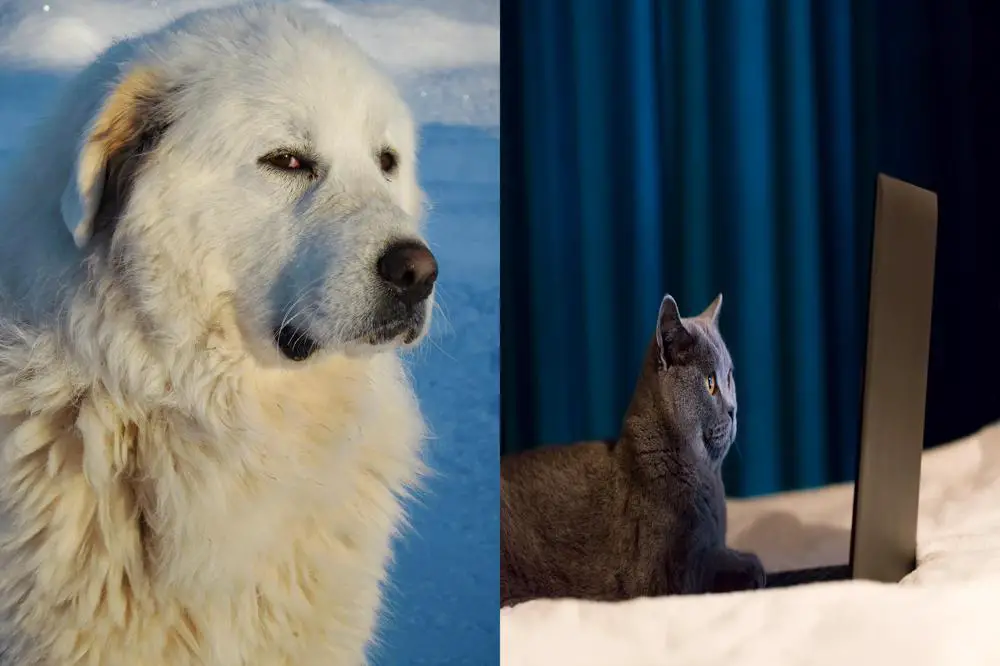
Dogs have more neurons in their brains than cats. In fact, a dog has twice the number of brain neurons of a cat (500 million versus 250 million neurons).
This is according to a research study in which the scientist counted the number of brain neurons in dogs and in cats.
Brain neurons are used for processing information. Hence, it is likely that the Great Pyrenees will have a better information processing power than a cat
Thus, if we are to use the number of neurons in an animal`s brain as a measure of intelligence, then the Great Pyrenees is definitely way smarter than a cat because the Great Pyrenees has twice as many brain neurons as a cat.
However, intelligence is a very complex concept that may not be explained simply by how many neurons an animal`s brain has. Learn more here.
What is the IQ of the Great Pyrenees?

Before discussing the Intelligence Quotient (IQ) of the Great Pyrenees, let us first define what Intelligence Quotient (IQ) is. IQ is simply a measure of how mentally advanced a person is relative to that person`s chronological age (the typical age that is calculated from birthday).
For example, a 2-year-old child with the mental capacity of a 4-year-old has an IQ of 200 (that is 4 divided by 2, multiplied by 100).
This is an old but simple definition of IQ.
According to Prof. Stanley Coren, a dog has the mental capacity of a 2-year-old human child.
Let us assume that Great Pyreneess become full-grown and reach mental maturity at one year of age.
Also, let us make the bold assumption that, as Great Pyreneess get older, they do not get significantly smarter than a 2-year-old human child (You Can`t Teach an Old Dog New Tricks).
Thus, a one-year-old Great Pyrenees will have the mental capacity of a 2-year-old human child, and a 2-year-old Great Pyrenees will still have the mental capacity of a 2-year-old human child, and a 3-year-old Great Pyrenees will have the mental capacity of a 2-year-old human child, and so on.
Then, from the way IQ is defined, a one-year-old Great Pyrenees, which will have the mental capacity of a 2-year-old child, has an IQ of 200! This is not too surprising because Great Pyreneess mature and age faster than humans.
A one-year-old Great Pyrenees is twice as smart as a one-year-old human child.
Also, since a 2-year-old Great Pyrenees will have the intelligence of a two-year-old human, then the corresponding IQ of a 2-year-old Great Pyrenees is 100. Similarly, a three-year-old Great Pyrenees will still have the mental capacity of a two-year-old human, making its IQ 66, and so on.
These may sound odd. But this is because the concept of IQ was designed to test human intelligence and not Great Pyrenees intelligence. That is what you get when you use human intelligence as a reference to measure Great Pyrenees intelligence.
Conclusion
We hope this article has provided you with all the facts you need to know on Great Pyrenees intelligence.
To learn more about the Great Pyrenees, check out our article where we reviewed the Great Pyrenees breed.
Also, to learn more about the temperament and behavior of the Great Pyrenees, check out our article on the temperament profile of the Great Pyrenees. This will tell you what Great Pyreneess are really like.
If you do not own the Great Pyrenees yet, and you are planning to get one, check out our list of reputable Great Pyrenees breeders and article on Great Pyrenees price and buying advice.